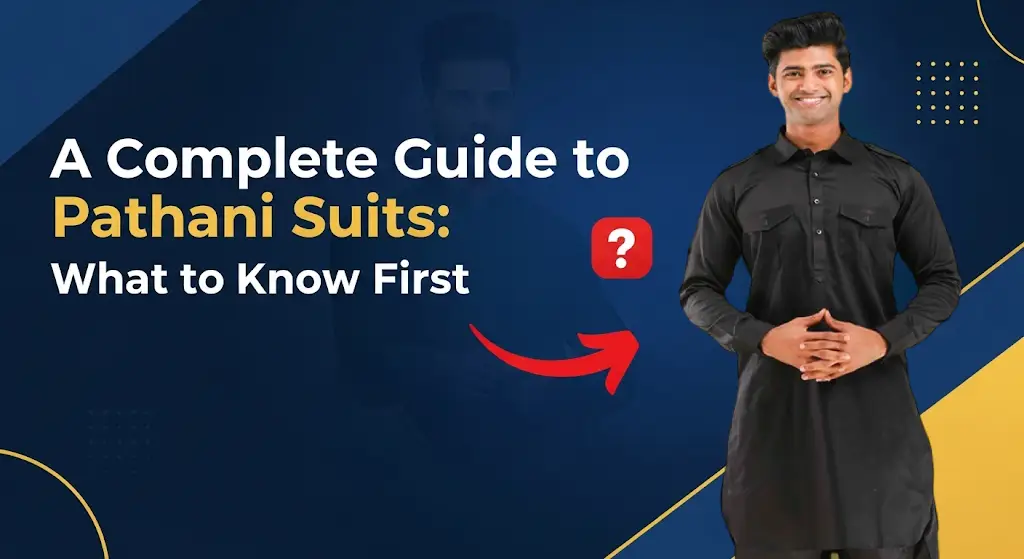Table of Contents
The Pathani Kurta Pajama:
It carries a strong, grounded look. Its structure adds weight to the frame, and its design has long been associated with resilience and clarity in style. This isn’t a loud garment, its impact comes from how it holds shape, moves with the body, and reflects a kind of no-frills masculinity that doesn’t need explaining.
In this guide, we will explore every facet of this iconic ensemble, from its rich origins to the art of wearing and caring for it, ensuring you know everything before incorporating it into your wardrobe.
The widespread popularity of the Pathani suit, extending beyond its specific regional roots, attests to its function as a cultural bridge. While its origins lie in the Pashtun regions of Afghanistan and Pakistan, often recognized as a “Muslim dress,” its appeal has broadened to include Punjab and even Bollywood stars.
This cultural diffusion highlights that the Pathani suit is not solely an ethnic garment, but a symbol that appeals to a broader demographic through its inherent style and comfort, making it a shared emblem of South Asian masculine elegance.
A Rich History of the Pathani Suit/Kurta Pajama
The Pathani’s narrative begins in the Pashtun regions of Afghanistan and Pakistan, where it was also known as the Khan suit or Kabul suit. Its initial purpose was entirely practical. Due to its loose-fitting design and adaptability to varying temperatures, it became the preferred attire for nomadic tribes. It met the demands of their lifestyle, providing ease and protection during their travels.
This garment evolved from the traditional Pashtun dress, ‘Perahan tunban’ or ‘Partoog kameez.’ The ‘Perahan’ or ‘kameez’ is the upper garment, similar to a kurta, while the ‘tunban’ or ‘partoog’ is the lower garment. This evolution marks a transition from a basic, functional garment to a distinct cultural ensemble.
A particularly intriguing turn in the Pathani suit’s history connects it to Punjab in the early 19th century. One historical account suggests that Pashtuns adopted the traditional Punjabi shalwar kameez after repeated defeats by the Sikhs, led by General Hari Singh Nalwa. Facing the threat of capture and aware of Nalwa’s fierce reputation, the Pashtuns observed Sikh women wearing the shalwar kameez.
They decided to adopt the same attire to evade detection. It is a remarkable transformation how a garment, initially adopted as a tactical disguise for survival, became fully integrated into Pashtun culture over decades and eventually known as the Pathani kurta pajama.
This stands as a testament to how clothing can be adopted for practical reasons, yet over time, it becomes deeply embedded in a new cultural identity. It shows the dynamic relationship of fashion with socio-political events.
This garment, once a “utilitarian design” for nomadic tribes , is now worn as “formal wear” for “special occasions” and is seen as a “masculine outfit”. This transformation indicates a significant cultural shift. It shows how from a basic necessity to a fashion statement, there has been a deliberate cultural acceptance and aesthetic refinement in the garment’s design and perception.
Key Features of the Pathani Kurta Pajama
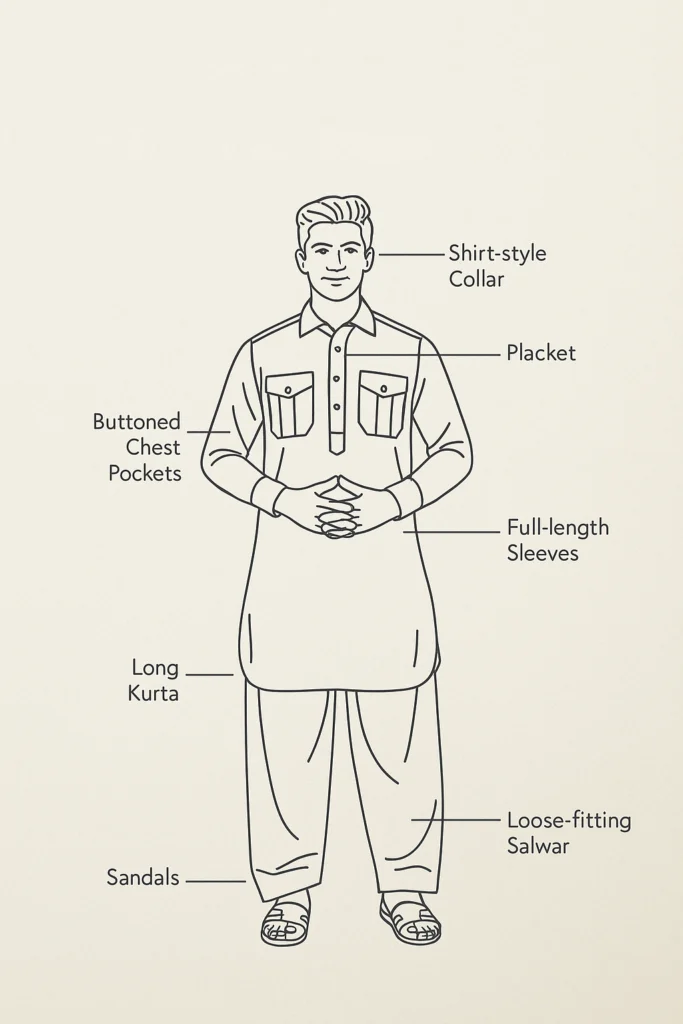

The Pathani kurta pajama is identified by its core components, which include a long kurta (tunic), a salwar (loose-fitting trousers), and an optional vest or waistcoat. This combination offers a distinct balance of ease and style.
The kurta, the centerpiece of this ensemble, is recognized for its distinct features. It has a sleek shape and a straight cut, enhancing a strong and masculine appearance. The kurta typically extends below the knees and has a loose fit, providing comfort to the wearer. It features a regular shirt-like collar , and often includes large front pockets with buttons, contributing to its robust aesthetic. Sleeves are usually full length, sometimes with button tabs for folding.
The salwar, the lower garment, is wide at the top and narrows towards the bottom, creating a distinct drape that complements the kurta’s loose cut. A key characteristic of the Pathani kurta pajama is that the kurta and salwar are usually of the same color, creating a harmonious and cohesive look.
This ensemble can also be worn with a Nehru jacket or vest, which elevate its elegance and make it adaptable for various occasions. The “loose fit” of the Pathani kurta pajama, initially designed to “adapt to different temperatures” , has evolved into a “sleek shape” and “straight-cut silhouette”.
This reflects the garment’s progression, where initial practical design elements have been refined and stylized for fashion. The inherent ease and freedom of movement were retained, but the cut was refined to create a more “masculine” and “dashing” aesthetic, making it both practical and stylish.
Selecting Materials for Your Pathani Kurta Pajama
The choice of fabric for a Pathani kurta pajama determines not only its ease and drape but also its suitability for the occasion and its overall aesthetic. This is a crucial decision that can elevate the impact of your ensemble.
Traditionally, Pathani kurtas have been made from cotton, silk, or poly-cotton blends. However, a wider array of options is available for the modern gentleman:
- Cotton: This is light, easy, and breathable, making it ideal for casual summer events. However, some advise against cotton for its tendency to wrinkle easily. Still, high-quality cotton is highly favored for its comfort.
- Linen: A thin and breathable material, linen is perfect for warm weather and informal parties. Its natural wrinkling is part of its appeal, giving a relaxed and effortless look.
- Silk: A precious and luxurious material, silk is often chosen for formal occasions, weddings, and festive wear. It provides a smooth finish that enhances elegance.
- Wool (Merino, Worsted): Due to its adaptability and high-end appearance, wool is an excellent choice for Pathani suits. It is breathable, resilient, and wrinkle-free, making it suitable for both warm and cool climates. “Superfine all wool jacquard fabric” is particularly recommended for sharpness and refinement.
- Rayon/Viscose: These fabrics offer a slight sheen and flow, making them suitable for evening wear. They can also be a budget-friendly option.
- Khadi: Known for its easy fitting, khadi is a popular choice for Pathani kurta pajama that prioritize comfort.
- Satin: For a less expensive yet refined look, satin can be a good option.
- Polyester (Blends): Polyester is a synthetic fabric often blended with wool. It is durable and low-maintenance, though not as breathable as natural fibers.
The fabric selection depends on several factors:
- Occasion: For formal events, fabrics with a smooth finish and no patterns are recommended, while lighter fabrics are best for casual occasions.
- Budget: Your willingness to spend also plays a decisive role in fabric selection.
The direct contradiction regarding cotton, where some advise against it for wrinkling while others emphasize its comfort, illustrates a common dilemma in fashion: prioritizing aesthetic “sharpness” (less wrinkling) versus practical “ease” (breathability). This shows that there is no single “best” fabric; the choice is a nuanced decision based on the occasion, climate, and individual preference.
Pathani Kurta Pajama Fabrics
| Fabric Type | Key Characteristics | Suitable Occasions | Nawab Parker’s Note |
| Cotton | Light, easy, breathable, can wrinkle | Casual, daily, small gatherings | For relaxed refinement; choose good quality. |
| Linen | Thin, breathable, natural wrinkling, easy | Informal parties, daytime events | For an effortless, relaxed elegance; embrace the wrinkles. |
| Silk | Luxurious, smooth, expensive, splendid drape | Formal occasions, weddings, festivities | For grandeur and refinement; ideal for evening wear. |
| Wool (Merino/Worsted) | Adaptable, high-end, breathable, wrinkle-free, resilient | Formal, business, high-end gatherings | For sharp elegance and excellent drape. |
| Rayon/Viscose | Slight sheen, good flow, budget-friendly | Evening events, casual to semi-formal | For affordable style and a subtle gleam. |
| Khadi | Easy, breathable, rustic texture | Casual, cultural events | For authentic ease and a traditional feel. |
| Satin | Smooth, lustrous, less expensive silk alternative | Semi-formal, party wear | For a luxurious appearance that will not break the bank. |
| Polyester Blend | Durable, less expensive, less breathable | Casual, business casual | A budget-conscious option; choose blended with wool for better quality. |
Colors and Patterns for Every Occasion
The selection of colors and patterns for a Pathani kurta pajama allows a gentleman to express his style for various occasions. Color is not merely an aesthetic preference; it is a deliberate choice that reflects the wearer’s intent for the occasion.
Start with black — it holds everything together
Black doesn’t flex with trends. It doesn’t reflect light or color-shift under different environments. It doesn’t clash with accessories, and it can be styled with or without a jacket. That’s why it’s the foundation of most functional ethnic wardrobes.
Our Black Pathani Kurta Pajama for Men – Wedding & Festive Style
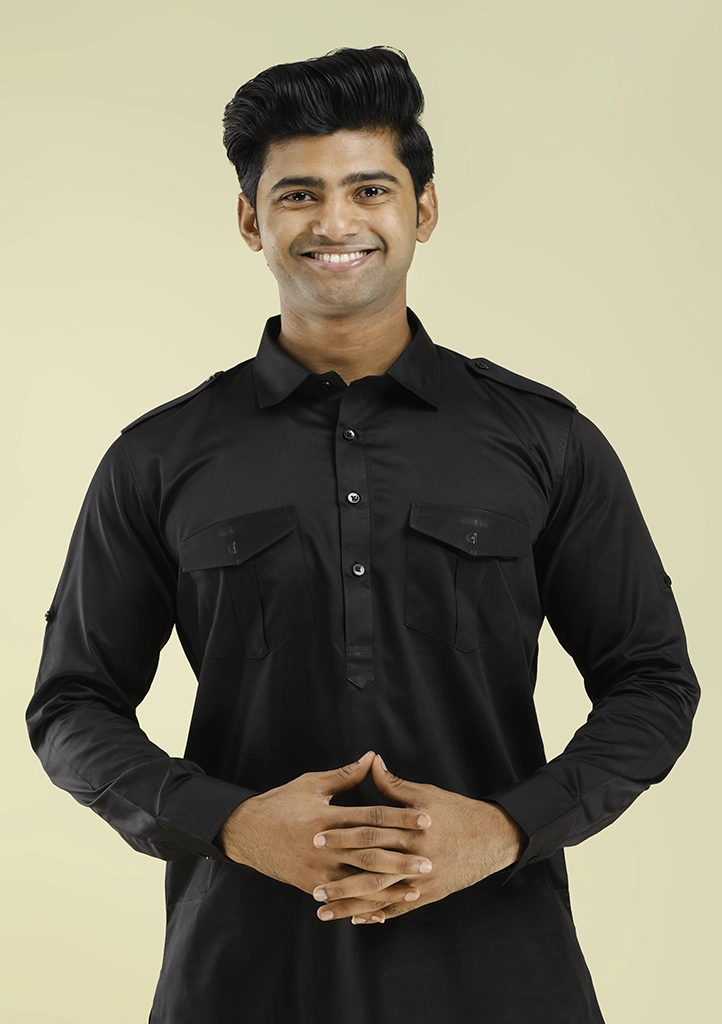

→ View Product
works across evening receptions, formal dinners, and public appearances. The structure holds up under jackets or shawls, and it maintains shape over repeat wear.
Pair it with mojris or closed leather sandals. Do not over-layer. The product performs best when left unembellished.
White is precise — but not casual
A white Pathani suit is not a casual outfit. It’s crisp, high-contrast, and visually exacting. That’s what makes it useful for daytime ceremonies, Eid, or pujas.
Our White Pathani Kurta Pajama for Men – Eid Traditional Design
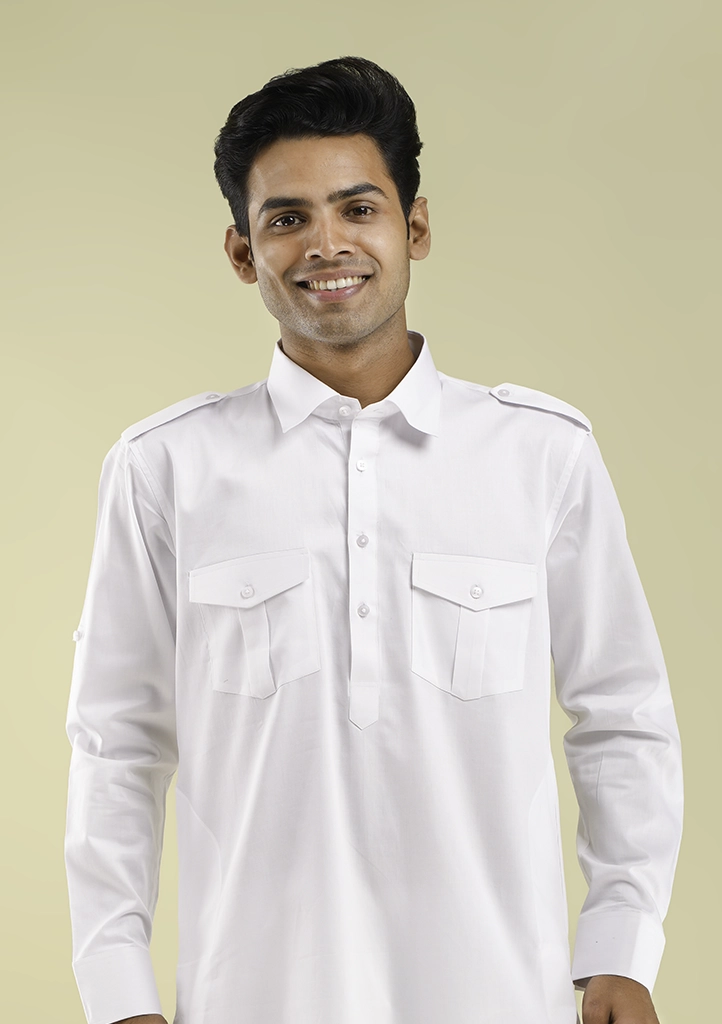

→ View Product
is built around that logic. The cut is clean, the color finish is high-opacity, and it pairs well with either a light-colored Nehru jacket or worn solo.
It’s not meant for crowded evening events. It’s meant to reflect clarity in indoor or daylit environments. Maintain it with proper folding and storage — color retention matters here more than on dark suits.
Mid-tones offer your third layer of flexibility
Between black and white sits a wide range of mid-spectrum Pathani suits. These include navy, olive, dark green, rust, and cream. You don’t need all of them. You need 1–2 strong options based on what you’re likely to attend.
Our Navy Blue Pathani Kurta Pajama for Men – Punjabi Wedding Wear
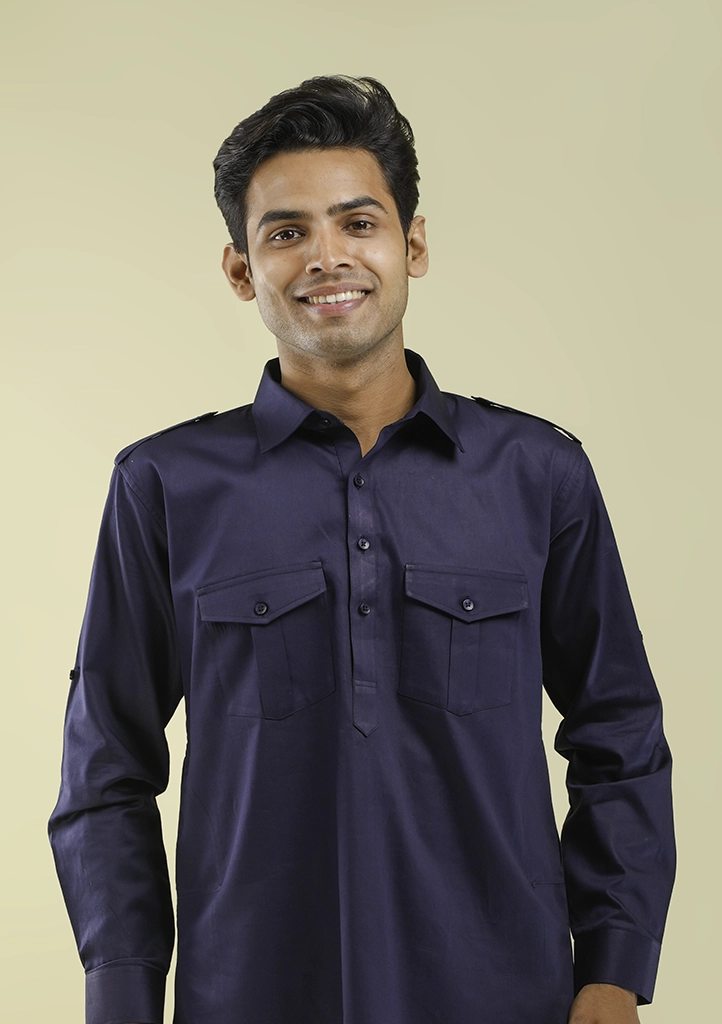

→ View Product
serves this function well. It’s dark enough to remain formal, but less stark than black. It adapts better to maroon, grey, or cream jackets and can be styled across multiple functions without looking repetitive.
Our Cream Colour Pathani Kurta Pajama – Eid Special
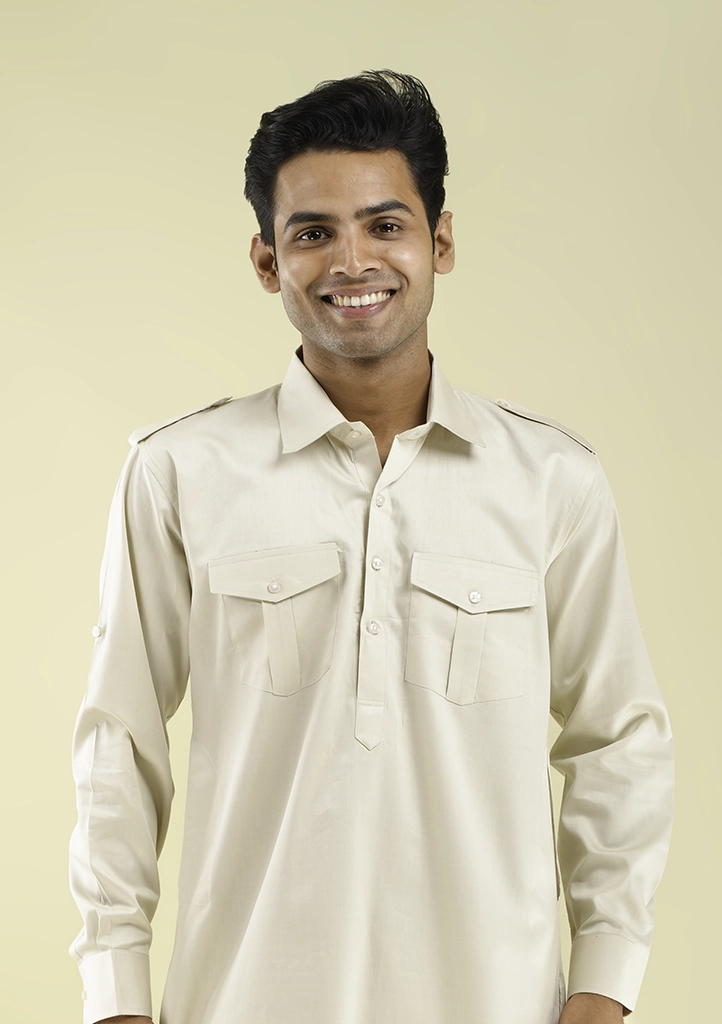

→ View Product
offers a lighter variation that works for semi-formal daywear. It pairs well with contrast layering and functions as a second-day wedding option or festival morning wear.
Add one festive tone — for visual variation
One suit in your rotation should break from the neutrals. Not for novelty — but to be visible when the event demands it.
Our Bollywood Style Maroon Pathani Kurta Pajama
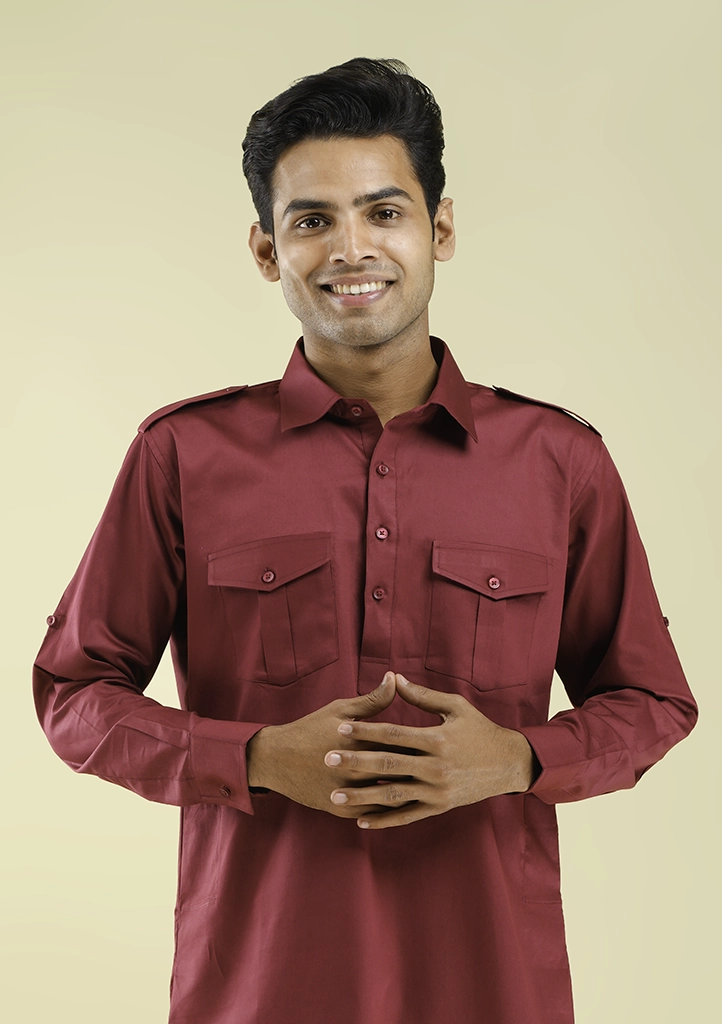

→ View Product
gives you that shift. The color works for evening sangeets, post-wedding receptions, or Diwali gatherings. This is not your primary suit. It’s your impact piece. Wear it sparingly, store it carefully, and rotate it for events that need visual weight.
If maroon isn’t your preference, the Dark Green Pathani Kurta Pajama for Men
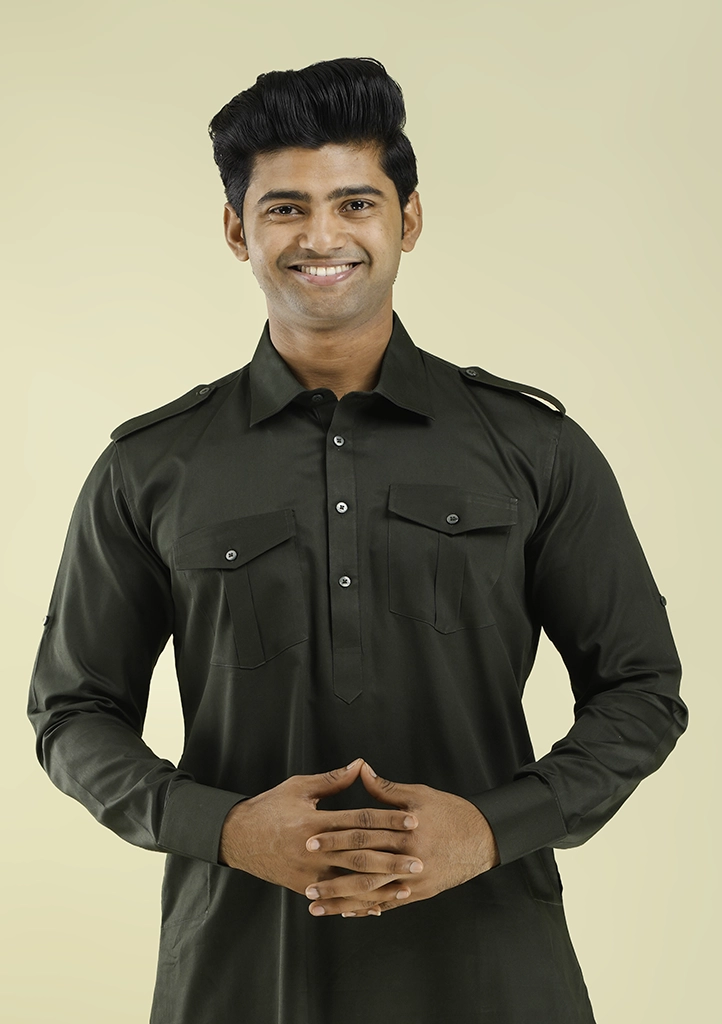

→ View Product
offers a richer, more grounded tone. It avoids visual fatigue and holds better under daylight or mixed lighting than brighter shades.
Keep one traditional variant if your events are regional
If you attend Punjabi weddings, cultural gatherings, or traditional occasions where a hint of regional styling is expected, one suit should reflect that.
Our Punjabi Style Brown Pathani Kurta Pajama for Men
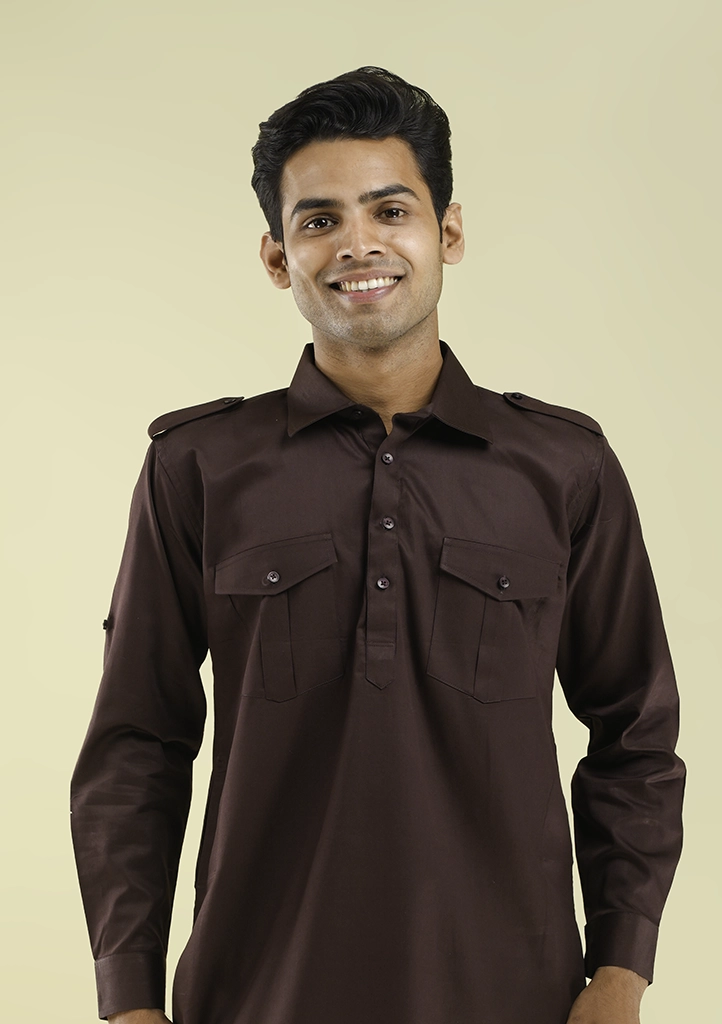

→ View Product
offers regional alignment without going into full ceremonial wear. The brown tone keeps it understated, while the overall structure remains aligned with Nawab Parker’s product logic: minimal surface detailing, proper drape, and long-wear utility.
Note: All Pathani kurta pajamas shown here are from Nawab Parker’s current collection. Each set is made in-house, with a fixed cut and verified measurements for different sizes.
The fabric is selected based on usage — not visual trends. Black and dark tones are treated for fade resistance. Light colors are lined for opacity. Collars and cuffs are stabilized to prevent slouching.
These are functional garments made for repeated wear across formal and festive use cases.
The wide range of colors in Pathani suits, from “evergreen black and white” to “vibrant hues” and “pastel shades” , indicates that color is not merely aesthetic, but a deliberate choice reflecting the wearer’s intent for the occasion. This shows a conscious decision-making process where color conveys formality, festivity, or casualness. Black symbolizes elegance , white purity , and vibrant colors for lively events , elevating color from a simple attribute to a strategic element of personal expression.
Occasions for Your Pathani
The versatility of the Pathani kurta pajama is remarkable, making it an ideal choice for a wide array of occasions, spanning from formal grandeur to refined casualness. This shows its adaptability, transforming it from a traditional garment into a versatile fashion statement capable of conveying various levels of formality and personal style.
Formal Grandeur:
- Weddings and Related Festivities: Pathani suits are highly popular for weddings, engagements, receptions, mehndi, shaadi, sangeet, and Jaggo traditional parties. They are considered “formal wear” and can be chosen by grooms and their party members. A Pathani for men wedding or a wedding Pathani kurta is a common sight. We see many Pathani wedding dresses for men and a Pathani kurta pajama for wedding being chosen for these grand events. A Pathani kurta for men wedding is a popular choice.
- Festivals: Ideal for Eid, Diwali, Holi, Navratri, and other cultural celebrations. A
- For Eid is a particularly favored choice.
- Other Formal Events: Official events, large meet-ups, and parties are also suitable occasions for a Pathani suit.
Refined Casual and Daily Wear:
The “Khan-dress” or Pathani suit is also a daily attire among Bollywood heroes , suitable for any season.
Shorter Pathani kurtas are ideal for casual events, family gatherings, or small office functions. A
half Pathani kurta offers a modern, casual twist.
It is also favored for casual outdoor events or travel gatherings.
Bollywood celebrities, particularly icons like Shah Rukh Khan , have popularized and modernized Pathani kurta pajama trends, making them synonymous with royalty and opulence. This influence underscores the Pathani suit’s broad appeal and its continued relevance in the fashion world. A
Bollywood Pathani kurta pajama or simply a Bollywood Pathani kurta reflects this celebrity endorsement.
The versatility of the Pathani suit, described as suitable for various occasions (weddings, festivals, casual outings) , shows its remarkable adaptability. It has transformed from a traditional garment into a versatile fashion statement, capable of conveying various levels of formality and personal style. This indicates that the Pathani kurta pajama is no longer confined to a specific category, but is a highly adaptable garment, allowing men to express their style in diverse social contexts.
Styling Your Pathani Suit
Styling a Pathani suit is more than simply wearing clothes; it is a deliberate act of conveying a specific aesthetic, which can range from traditional elegance to modern flair. This is where the Pathani kurta pajama for men design truly comes to life.
Grand Layering:
- Nehru Jacket: A classic and popular option with a Pathani suit, adding elegance and style. It can also be chosen in a contrasting color or print to the kurta.
- A black Pathani kurta pajama with jacket creates a striking ensemble.
- Vest/Waistcoat: This is an optional component of the suit , but also a stylish layering option.
- Shawl/Stole: Adds a touch of elegance, especially during festive ceremonies or cooler climates. It can be worn for “traditional attire with a shawl”.
- A Pathani kurta pajama with shawl is a distinguished look.
Footwear Finesse:
- Ethnic Sandals/Mojaris: Enhance traditional appeal and an “old school” feel.
- Leather Shoes: Are also a suitable option.
- Sneakers/Sandals: For a more casual, relaxed look.
Accessorizing Wisely:
- Turban: A popular headpiece that enhances the festive spirit.
- Ornaments: Delicate gold necklaces/simple pendants for casual wear; pearl necklaces/malas for weddings.
- Watches: A classic metal watch with a leather strap complements the flap collar style.
- Sunglasses: Can complete an Indo-Western look.
- Belt: A coordinated belt for a polished appearance.
Modern Interpretations: Pathani suits are being adapted with contemporary touches, such as asymmetric designs, unique cuts, and a blend of various design aspects. “Short Pathani kurtas” have emerged as a fashionable Indo-Western creation, offering a youthful and modern appearance.
A stylish Pathani kurta pajama or a specific Pathani kurta pajama style can incorporate these modern elements. The overall kurta pajama Pathani style is evolving. A Pathani kurta style can vary greatly depending on the occasion and personal preference.
The emphasis on specific pairings, such as Nehru jackets, shawls, and particular footwear , shows that styling the Pathani suit is not an afterthought, but a deliberate act of conveying a specific aesthetic, be it traditional elegance or modern flair. This highlights how each styling choice, such as a Nehru jacket adding “elegance and style” or a shawl providing “added elegance” , is an active choice by the wearer to curate their look, making the Pathani suit a medium for individual expression.
How to Care for Your Pathani Suit
Careful attention to the care and maintenance of your Pathani kurta pajama extends its lifespan and preserves its pristine appearance, ensuring this enduring garment retains its grandeur for years to come. This is an investment in longevity, aligning with a discerning gentleman’s appreciation for quality and lasting value.
Practices:
- Air Drying: After each use, hang your suit on a wide-shouldered padded or wooden hanger in a well-ventilated area for a few hours. This allows the fabric to breathe, removes odors, and helps minimize wrinkles. Remember to empty the pockets to maintain the suit’s silhouette and keep the lining in good shape.
- Brushing: Regular brushing with a horsehair brush or lint roller removes dust and debris, maintaining a fresh appearance. Always brush downwards to effectively remove particles.
- Spot Cleaning: Address stains promptly by gently dabbing them with a fabric cleaner or mild detergent and a clean cloth, avoiding excessive scrubbing as it can damage the fabric.
Periodic Care:
- Steaming vs. Ironing: Prioritize steaming over ironing to gently smooth out wrinkles and deodorize. If ironing is necessary, use a low to medium heat setting and place a clean press cloth between the iron and the fabric to protect it.
- Dry Cleaning: Dry clean as infrequently as possible to avoid chemical exposure and extend its lifespan. Recommended frequency: blazers no more than four times a year, and trousers no more than once a month, especially if worn frequently.
Proper Storage:
Always hang your suit on a wide-shouldered padded or wooden hanger to maintain its shape and prevent wrinkles. Wooden hangers are particularly beneficial as they help absorb any damaging moisture.
When storing your suit in a closet, ensure it has ample space to breathe. Avoid overcrowding, as this can lead to moisture accumulation and potential damage to your suit.
If you do not plan to use your suit for a while, store it in a breathable cloth garment bag to protect it from dust and moths.
The volume and specificity of the care advice (air drying, brushing, steaming, limited dry cleaning, specific hangers, garment bags) suggest that these garments are meant to last. This contrasts with “fast fashion.” The emphasis on “extending the life of your suits and saving money in the long run” directly links care to value and sustainability.
How to Care for Your Pathani Suit
| Care Practice | Do’s | Don’ts | Why It Matters |
| Air Drying | Hang on wooden hanger in ventilated area after each use. Empty pockets. | Do not hang in crowded spaces. | Allows fabric to breathe, removes odors, minimizes wrinkles. |
| Stain Treatment/Brushing | Gently dab stains with mild detergent. Brush downwards with horsehair brush. | Do not scrub excessively. Do not brush upwards. | Prevents stains from setting, removes dust and debris, keeps it fresh. |
| Steaming/Ironing | Use steamer to smooth wrinkles. If ironing, use low heat and press cloth. | Do not iron directly on fabric. Do not use high temperatures. | Preserves fabric quality, removes wrinkles, deodorizes. |
| Dry Cleaning | Dry clean only for visible dirt/odors. Blazers 4x/year, trousers 1x/month. | Do not dry clean too frequently (due to chemical exposure). | Maintains fabric integrity, extends lifespan. |
| Storage (Hanger) | Use wide-shouldered padded or wooden hangers. | Do not use wire hangers (damages suit shape). | Maintains suit shape, prevents wrinkles, absorbs moisture. |
| Storage (Space) | Allow ample space in closet. | Do not overcrowd closet. | Allows air circulation, prevents moisture and damage. |
| Storage (Garment Bag) | Use breathable cloth garment bag for long-term storage. | Do not use plastic or canvas bags (block air). | Protects from dust and moths, allows fabric to breathe. |
Final Word
The Pathani kurta pajama, from its humble and practical origins to its current status as a refined garment for the modern gentleman, has journeyed remarkably. It is not merely an outfit; it is a cultural narrative, a testament to adaptability, and an enduring statement of style.
This garment, once a functional necessity for nomadic tribes, is now a symbol of masculine elegance, finding its place at various occasions, from weddings and festivals to casual daily wear. Its versatility, its availability in diverse fabrics and colors, and the ability to style it with accessories like Nehru jackets or shawls, make it an indispensable item for the modern gentleman.
Investing in a Pathani kurta pajama is a commitment to quality and heritage. With proper care and maintenance, this garment will retain its sharpness and elegance for years to come, reflecting the wearer’s refined taste and cultural appreciation. It is a garment that has stood the test of time, continuously evolving yet remaining true to its core identity.
For Nawab Parker, the Pathani kurta pajama is more than just clothing, it is an enduring statement of cultural pride, masculine elegance, and enduring style. Embrace it, wear it wisely, and let it become a part of your personal narrative.
Written by Nawab Parker
Nawab Parker is a menswear label based in Patna, designing structured ethnic wear for Indian men. Our Pathani, Sherwani, and Kurta Pajama for men are crafted for real-world use across weddings, festivals, and formal settings.
FAQs
What’s the difference between a regular kurta pajama and a Pathani kurta pajama?
A Pathani kurta pajama includes a shirt-collar kurta and salwar-style bottoms. It has a straight-cut silhouette, often with chest pockets and buttoned plackets. Standard kurta pajamas usually have a round or band collar and a more traditional ethnic cut.
Can I wear a Pathani kurta pajama to a wedding?
Yes. It’s often worn by groomsmen or guests. Darker tones work well for evening events. Add a jacket or shawl to increase formality.
Is the Pathani suit only for Muslim festivals?
No. While the design has roots in Pashtun and Muslim communities, it is now widely worn across weddings, cultural functions, and daily wear by men of all backgrounds.
What footwear goes best with a Pathani kurta pajama?
Mojaris, leather sandals, or plain loafers. Avoid heavy sneakers or sports shoes unless styling casually.
Which fabric is best for a Pathani suit?
Depends on use. For casual settings, cotton or khadi works. For formal wear, silk blends or wool are preferred. We use a high-grade silk blend that holds structure, drapes well, and performs across multiple wears without losing shape. We avoid glossy synthetics and unstable finishes.
Can I machine-wash my Pathani suit?
For basic cotton sets, cold machine wash is fine. But Nawab Parker’s Pathani suits are made using high-quality silk blends, which require more care. Dry cleaning is recommended. If needed, light hand-wash is possible, no hot water, no bleach, no wringing. Avoid machine drying completely.
How should a Pathani kurta pajama fit — tight or loose?
It should have a structured but relaxed fit. The kurta should fall straight without clinging to the body. The salwar should taper cleanly without excess bunching. Nawab Parker cuts are designed to balance movement with shape, not tight, not oversized.


